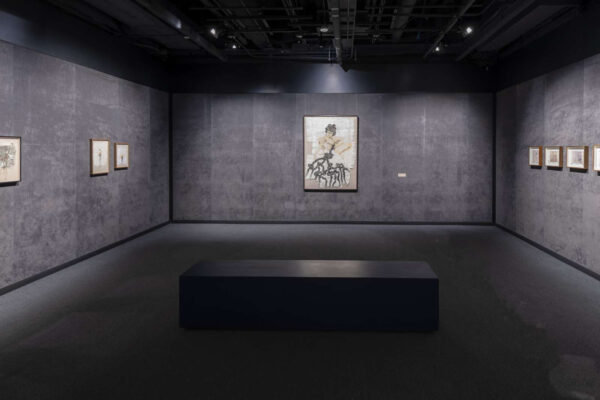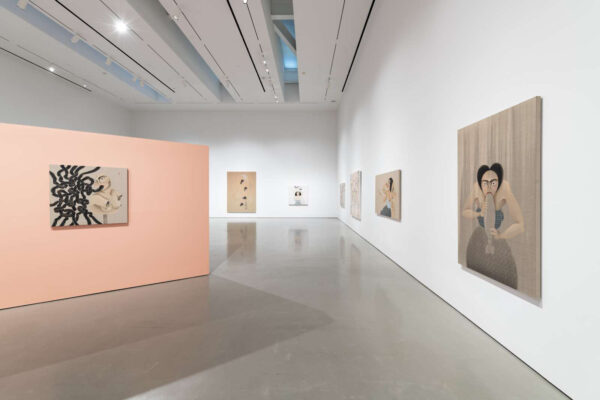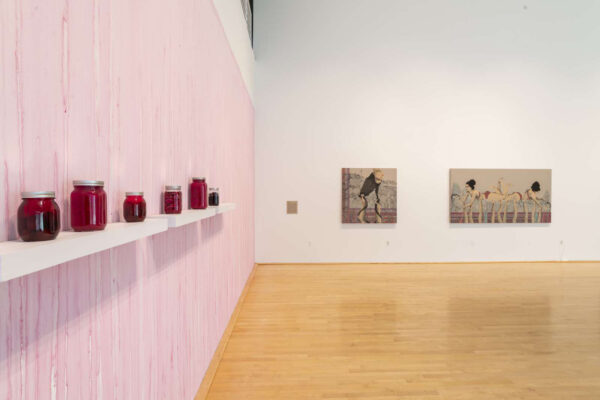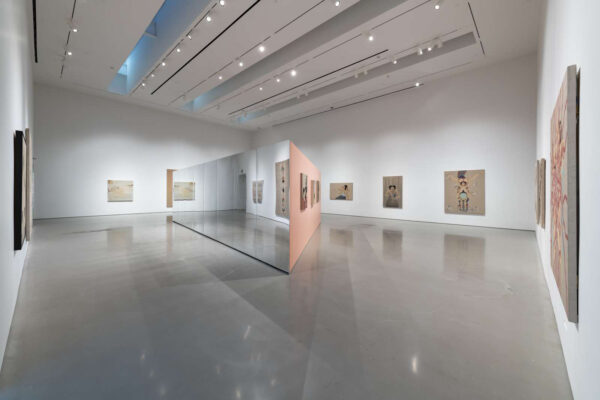
Installation view of “Hayv Kahraman: The Foreign in Us,” on view at the Moody Center at Rice University.
A neat retrospective of Iraqi-American painter Hayv Kahraman’s latest paintings on linen and paper presents an overview of her main topics or, rather, variations on the main throughline of her work, that of the mutability of the Other. Kahraman has long ago committed herself to one character, a close-but-not-quite approximation of herself, depicted with porcelain skin, candy red lips, and a swoosh — literally made with one move of a big brush — of black hair. This character, sometimes solo, sometimes multiplied, acts out various allegories of Otherness in a panorama of self-conscious exploitation.
Kahraman, in a way, is the quintessential foreigner, and her’s is a truly American story of a refugee from yet another proxy war. She left Baghdad at the end of the Iran-Iraq War with her mother and grandmother, moving first to Sweden and then to Los Angeles. Like many before her and since, Kahraman arrived in the West unshielded from the barrage of stereotypes and preconceptions directed at her appearance, birthplace, accent, cultural background, and the like. Transforming discrimination into subject matter, Kahraman is uniquely attuned to any language or thoughtform that serves Othering, from outright racism to Imperial botany to contemporary epidemiology. Kahraman studied art in Europe, spent time in Florence, and had to reconfigure her manner in ways that made sense to her culturally. A melting pot, or a marriage of styles, emerged. Her athletic figures have freedom of movement and variance of gestures that is rarely enjoyed by female characters in Persian miniature, but the backgrounds are mostly uniform, showing the unprimed support in all its natural shimmer.

Installation view of “Hayv Kahraman: The Foreign in Us,” on view at the Moody Center at Rice University.
All the women in Kahraman’s paintings are figures of energy. She comes from a line of feminists, as her grandmother was one of the first women’s rights activists in Iraq. The poetics of traditional local patriarchy is a contrarian influence in her work. In one of her interviews, the artist mentions a depiction of the mythical ‘Waq Waq tree’ in a 14th-century Book of Wonders, compiled by Abd al-Hasan Al-Isfahani. This tree bears fruit in the shape of women, and if one falls with a gust of wind, a man can gather it and make love to it until it’s dead. Kahraman’s women are never consigned to the fate of a wet dream. Their sexuality is never directly seductive or static. Another impulse that shapes Kahraman’s work is decolonial. Kahraman told the Guardian that she wanted to “dismantle” linen’s association with Venice and “the heart of European aesthetics.” It makes conceptual sense, then, that the exhibition is treating her as a true Old Master, showing drawings, sketches, and even preparatory tools alongside finished work.

Installation view of “Hayv Kahraman: The Foreign in Us,” on view at the Moody Center at Rice University.
It makes all other kinds of sense, too, because the paintings are beautiful, and notably more so when there’s violence and physical discomfort on display. In the Not Quite Human series and other thematically adjacent works, the artist, who studied dance in her teenage years, creates human pyramids and acrobatic contortions for her auto-fictional character, making the results feel like a Cirque du Soleil performance directed by Alejandro Jodorowsky.
In Say Aah (2021) and Death Rattle (2020), Kahraman confidently walks the line between Platonic — that is, geometric — beauty and repulsion, making her stand-in draw out a snake from her mouth in the latter painting and suggestively caress the top of an aircraft bomb in the former (To soften? To disarm?). Here, the victim takes charge of the violence, embodying the drastic action against it.

Installation view of “Hayv Kahraman: The Foreign in Us,” on view at the Moody Center at Rice University.
In Torshi Vine (2022) and Entanglements with torshi no. 2 (2022), the artist extracts the natural pigment out of titular beetroot to paint an endless chain of gut-like forms that the characters either sort through or seem hopelessly caught in. Torshi makes another appearance in its pickled form on the wall of the first gallery, where Kahraman used the vegetable to create an abstract fresco. Probably the scariest paintings in the show are two NeuroBusts (both 2022), small works that depict severed heads and armless torsos with black guts coming out of select orifices. Calmer constellations of action and violence work less well. In recent years, Kahraman has taken to “marbling” her canvases, that is, positioning them atop of a pool of mixed paints. Marbling has taught her to “not have to know everything,” the artist told Vogue, but the veiling effect it produces seldom feels necessary. It turns the audience into voyeurs, trying to make out the human forms underneath, and steals some of the immediacy of the women’s presence.
Still, new variations to the paintings’ surfaces betray a restlessness that bodes well for the future of Kahraman’s personae. As do the manifold forms of Othering that the societies invent. By creating a parthenogenetic community of women who never stop defusing all sorts of violent situations and languages, Kahraman is unique in engaging the most charming forms to stand up to the biggest challenges.
Hayv Kahraman: The Foreign in Us is on view at the Moody Center for the Arts at Rice University through May 11, 2024.


